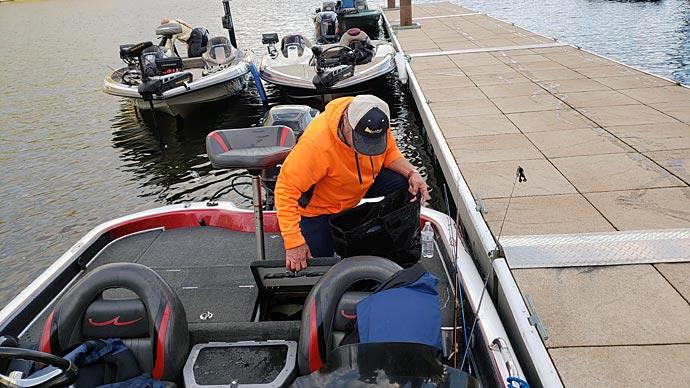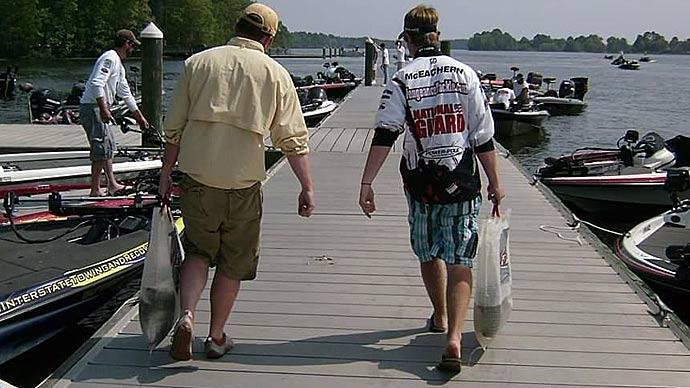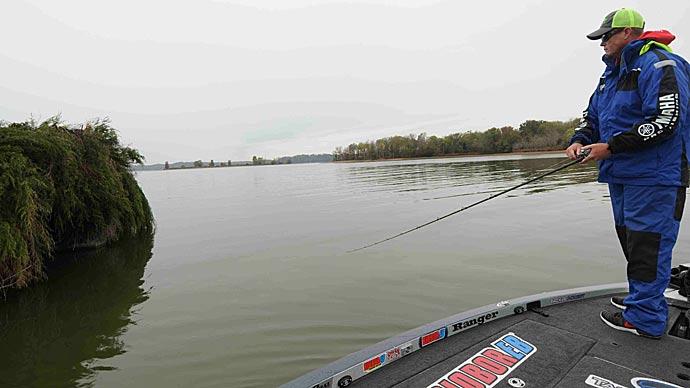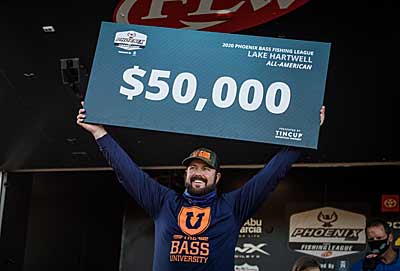
Gary Haraguchi is living the dream of many bass tournament anglers. The California native and his wife and their two new pups are traveling the country with a fifth-wheel camper, waiting for their new home in Idaho to be built. He’ll compete in three Major League Fishing Toyota Series divisions, Bassmaster Central Opens and select Northern Opens. And every cast he makes will be from the back deck.
Harguchi has found much success as a bass tournament co-angler. He’s finished in the money in 18 of the 26 B.A.S.S. tournaments he has entered, and he’s won three MLF tournaments — two Tackle Warehouse Pro Circuit events and one Toyota Series.
Entering a tournament as a co-angler — sometimes called no-boater or rider — can be a good decision for many reasons. It gives an angler the chance to learn the ropes, whether how to catch more bass or compete in tournaments. It can be a stepping stone to competing as a boater. And without the upkeep of a boat and tow vehicle, Haraguchi said it requires smaller investments in time and money. “It’s a lot more relaxed,” he said. “I can just show up and fish.”
Like Haraguchi, Justin Kimmel is a co-angler who’s no stranger to the top of the tournament standings. He won the 2020 Phoenix Bass Fishing League All-American on Lake Harwell, which the Athens, Georgia resident, considers his home water. He has won BFL regionals and regular-season tournaments, too. “If you want to do great in tournaments, that’s one thing,” he said. “If you want to learn, that’s fine. But when I show up, I’m competing.”
Cultivating a winning co-angler resume doesn’t happen by accident. Haraguchi and Kimmel have perfected the art of competing from the back deck. What they’ve learned can help all co-anglers, whether they're looking for more bragging rights in their local club, becoming a better bass angler, or dreaming of competing at the top levels of tournament bass fishing. They said that feeding that desire to do better starts with a question, maybe two.
Ask few questions
Co-anglers, to a large extent, are along for the ride on tournament days. The rules give boat control and location choice to the boaters. So, where they decide to fish is where their co-anglers fish. “I like that little bit of uncertainty,” Kimmel said. “Every co-angler is up against it. If you’re a good angler and keep your head on straight, the opportunities will come. You don’t know when they will come.”
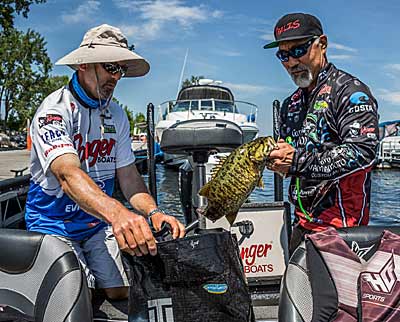
Not knowing where or how a boater plans to fish on tournament day is OK with Haraguchi, too. “I normally don’t ask what we’ll be doing,” he said. “For the most part, I try something different than my boater. I don’t decide what I will throw until we pull up to the spot. I try to fish in the moment.” If his boater is throwing a topwater, for example, he’ll improve his odds by fishing for the bass that his boater isn’t targeting, using a lure that runs subsurface or bumps bottom.
While there are rare occasions — his boater fishing fast and close to the bank with a crankbait, for example — when Kimmel is forced to fish the same lure and way, he usually opts for a different presentation and part of the water column, too. “There’s fish everywhere,” he said. “We’re learning that with forward-facing sonar.”
Even if bass demand a specific technique, Kimmel still seeks out a variation. For example, he might wake a spinnerbait if his boater is fishing a topwater. “If he goes to what I’m doing, I put it down,” he said. He’ll pick it back up once his boater puts it down. “It’s kind of a chess match,” he said.
What lure Kimmel picks up or switches to also depends on the clues he uncovers. He said even the wrong lure at the correct depth could tell you what bass want. If they’re biting the weight on your Carolina rig, for example, you know they’re feeding on the bottom, and a shaky head or jig, which puts your hook closer to the bottom, should result in more hookups. And if they’re nipping at your swimbait’s tail, switch to a lipless crankbait. Its treble hooks will ensure more of them go in your livewell.
Sometimes Haraguchi must ask a question. On Lake Champlain, the 125-mile-long lake that runs the line between New York and Vermont, a day spent fishing the northern end requires different specialized gear than one at its southern end. So, he’ll ask his boater which direction they’ll head. If it’s south, he grabs punching gear for largemouth. And if they’re headed north, it's spinning rods for smallmouth.
Kimmel is a co-angler of few questions, too. “There are two things I want to know,” he said. “First, are we fishing shallow, or are we deep?” For example, if his boater says shallow, he’ll skew his tackle selection toward techniques that shine there. But it’s not a complete commitment; he still brings a smattering of deep-water gear. “You never just want to go all-in,” he said. “You always want to be prepared for anything.”
Kimmel’s second question is about storage, specifically if he’ll have the use of a boat compartment where he can stash his gear. If one is open, he asks the boat model so he can estimate the compartment’s size and pack accordingly. If there won’t be one, he puts his tackle in a bag.
Embrace versatility
Kimmel’s early co-angler forays were all about power fishing — big rods, lines, and lures. But the opportunity to practice on New York’s Oneida Lake for a Bassmaster Northern Open with bass-fishing legend Mike Iaconelli, who opened his eyes to adding spinning rods to his quiver.
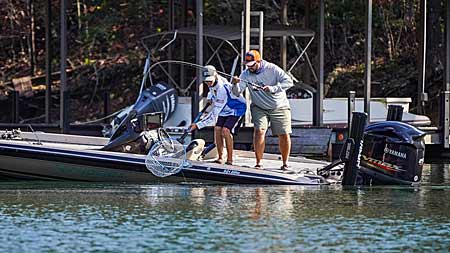
Kimmel’s single spinning rod broke, so he traveled to New York with only its reel, hoping multi-time MLF and Bassmaster winner Iaconelli would lend one of his to him. “He ripped me a new one,” he said. And he’s brought one, sometimes more, to every tournament since. “I just want to be ready for as many scenarios as possible,” he said. “It made me a complete angler.”
Haraguchi’s fishing background is diverse. He had the chance to fish in deep clear lakes, tidal water, and shallow water filled with aquatic vegetation on the West Coast. Those experiences made him a versatile angler, preparing him for the uncertainty of competing as a co-angler. “It’s not the boater’s job to get you your fish,” he said. “You have to figure out a way to catch them in the situation that you’re placed in.”
While finesse tactics are often a co-angler’s best option — Haraguchi always rigs a stick worm, such as Yamamoto’s Senko — you’ll do best with the techniques you have the most confidence in. Haraguchi said it will take time to find them and define your fishing style. Co-anglers see many techniques throughout the season; some are adopted into their regular rotation.
Pack properly
Haraguchi preps his prepare-for-anything approach in several ways. In addition to one or two specialized rod-and-reel setups, he completes his rod allotment — MLF, for example, restricts co-anglers to seven rods — with multipurpose outfits, each able to present several different types of lures in different covers and on different structures.
Selecting the range of lures needed takes planning, too. Start with those that perform best in the season that you’re fishing. Even then, you may need to bring many options. Kimmel’s main utility box doesn’t come from a tackle shop. Instead, he purchased it at a home-improvement store such as Lowe’s. Designed for tools and fasteners, it’s almost 4 inches deep and costs about $15. It’ll hold upwards of 40 jerkbaits or 100 crankbait or topwaters and fits most boats’ storage compartments.
Kimmel brings a smaller Flambeau box for vibrating jigs, spinnerbaits, and other wire baits. He also brings Flambeau’s Quotient IQ-140 for his terminal tackle. His soft baits go into one of three Missile Baits’ Missile Bags — one for straight-tail worms, one for baits with action appendages, and one for chunks, craws, and creature baits. “If I need something, I know exactly where it’s at,” he said.
Keeping tackle appropriately packed does more than facilitate lure changes. Kimmel said it also ensures more fish make it in the boat and to weigh-in. “I want a clean path,” he said. “I want to get to the net to catch [my boaters’] as much as I want him to get mine.”
Preparation will take a long way, but the last part is up to you. “The hard part is fishing clean,” Haraguchi said. “People are so good. You can’t lose a fish.” In 2018, he lost co-angler of the year on the Tackle Warehouse Pro Circuit by one point. He could point to several lost fish during the seven tournaments, and if he had landed one of them, his earnings would have gone to a bass boat instead of $10,000. “That’s a big difference,” he said.
Landing every bite is more critical to co-anglers than boaters because Haraguchi said they don’t often get enough bites for a limit. So, the entire weight of a lost fish, not what would be gained in a cull, disappears from his total weight.
Stay positive
Kimmel’s heard fellow co-anglers tell horror stories of draws and days that quickly went down the drain. But he’s never had one to share. And a big reason for that, he believes, is keeping a positive attitude, which in turn keeps him and a boater focused on fishing. “You don’t want to spin the captain out,” he said. “You can control what you can control. And you can start with your attitude. It comes down to we’re going fishing. Let’s get excited about it.”
Positivity pays off in plenty of predicaments. At his first BFL regional tournament win, he carried an almost 5-pound lead into the final day. His partner was Brandon Cobb, who would join the Bassmaster Elite Series a few years later. Even though that morning Cobb lost a 6-pounder, which most likely would have given him the win that afternoon, he made an effort to ensure Kimmel caught the bass that he needed.
Haraguchi is in the positive-attitude camp, too. Somedays, he becomes a cheerleader for his boater, reminding him there’s still time left and bass to be caught. And he’s always respectful, not casting near where his boater is fishing. “If you’re respectful to him, the day will go much better,” he said.


